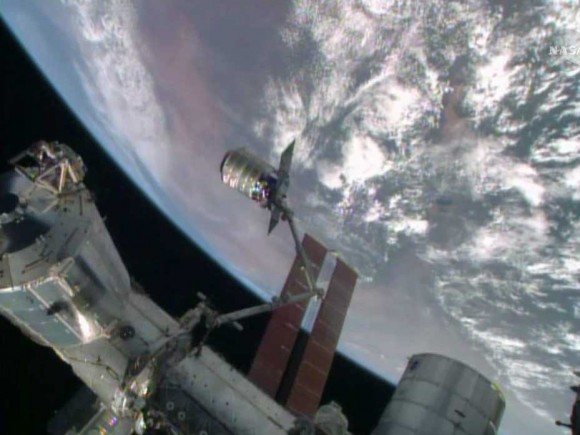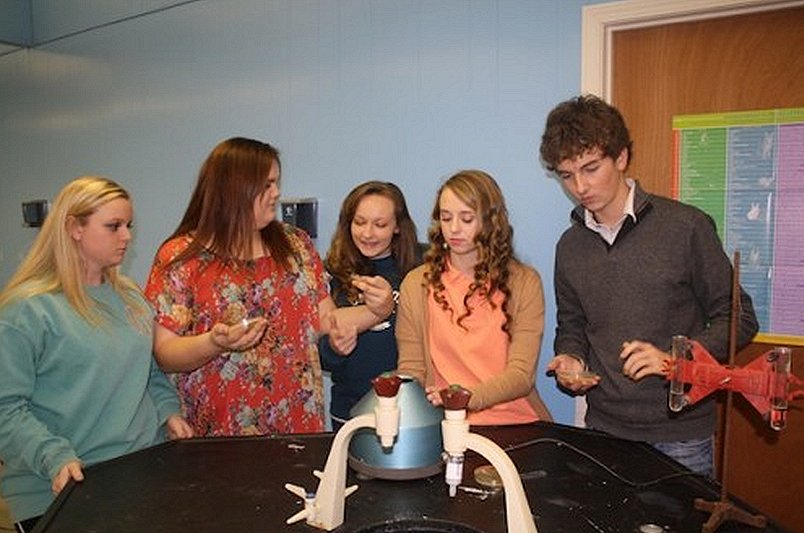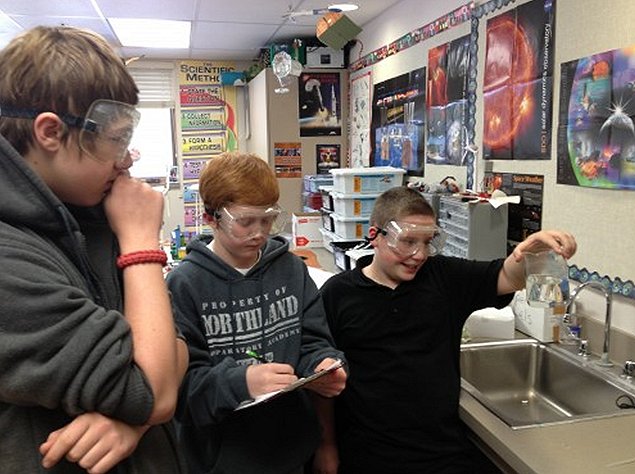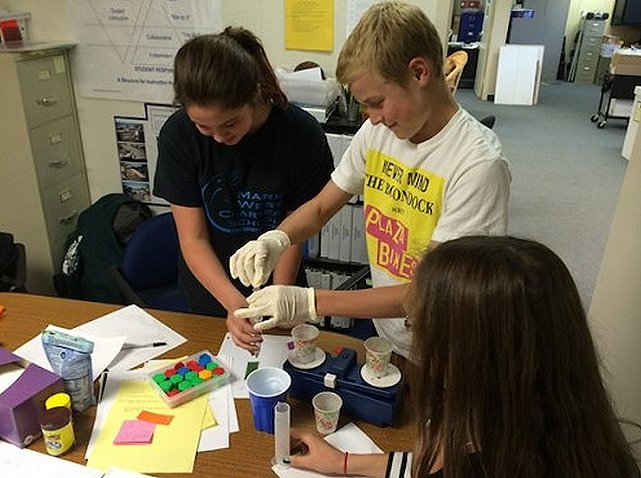
The International Space Station’s robotic arm, Canadarm2, grapples the Orbital Sciences’ Cygnus cargo craft named “Janice Voss” on July 16, 2014. Image Credit: NASA TV
Read more at Universe Today
The Orb-2/Cygnus vehicle successfully berthed with the International Space Station (ISS) at 8:53 am ET, yesterday, July 16, 2014.
Stacy Hamel, the SSEP Flight Operations Manager, has alerted all Mission 5 student research teams that we expect the first of the Charlie Brown experiments to be activated today by crew aboard ISS. Four student teams are preparing to initiate their concurrent ground truth experiments based on activity reports relayed from orbit to ground and posted on the SSEP Mission 5 to ISS: Experiment Log page.
Staff at the National Center for Earth and Space Science Education, and Arthur C. Clarke Institute for Space Education, are proud to report that NASA Johnson Space Center has written a feature article on Mission 5 science to be conducted aboard ISS. The article was published at the NASA ISS website on July 7, 2014, as Research News. Below is a reprint of the article, with permission from NASA.
From Antibiotics to Yeast: Latest Student Science Heads For Space
link to original article at nasa.gov
http://www.nasa.gov/mission_pages/station/research/news/ssep_mission5/#.U8e_nijn1sR
July 7, 2014
Melissa Gaskill
International Space Station Program Office
NASA Johnson Space Center
Astronauts on future missions may nibble on lettuce and grow their own antibiotics, depending on the results of research that student scientists plan to conduct on the International Space Station.

Brookhaven Academy student researchers examine their bacterium, Ralstonia eutropha.
Image Credit: SSEP
Mission 5 of the Student Spaceflight Experiments Program (SSEP) is scheduled to launch to the space station on July 11. A total of 1,344 proposals yielded 15 selected investigations for the flight. These investigations represent a diversity of subject matter from bacteria to tadpole shrimp and locations from Massachusetts to Arizona.
The provision of food in space proved popular, the focus of four studies. Students from Riebli Elementary and Mark West Charter School in California examine whether Triops longicaudatus, or tadpole shrimp, could be grown in microgravity as a food source for long-term missions. The species’ small size and high-protein content make that an attractive possibility.
Ninth-graders from Cesar Chavez Public Charter School for Public Policy in Washington, focused their attention on whether radish roots and shoots will grow differently in microgravity. Students from Cottage Lane Elementary in Rockland County, New York and Hillsborough County, Florida, envisioned astronauts growing their own lettuce. The Cottage Lane students hope to determine how long the plant takes to germinate in microgravity, while the Florida group looks at the frequency of lettuce seed germination in space.

Seventh graders from Northland Preparatory Academy preparing their onion cell study.
Image Credit: SSEP
Several investigations have potential applications for keeping humans healthy in orbit and on the ground. Northland Preparatory Academy students in Flagstaff, Arizona, will analyze how microgravity affects onion cell DNA replication. Onion cell mutations could have ramifications for other organisms, including astronauts. The team at Academy at Shawnee in Kentucky wonders whether microgravity would increase the rate of yeast fermentation in honey. Yeast fermentation on Earth is used to produce alcohol, which could be used as antiseptics or in food production in space.
A study by Murray Hill Middle School in Maryland investigates the effects of microgravity on microencapsulation, a process that could be used to help control the rate at which a drug is released in the body. If you cut a Dugesia Planarian worm would it grow back in microgravity? Sixth graders at North Attleborough Middle School in Massachusetts want to know the answer, which could eventually be put to use healing wounds in space and on Earth.
Students at Mendenhall Middle School in North Carolina will examine whether calcium sulfate crystals grown in space differ in size from those on Earth. Crystal formation may cause jellyfish born in microgravity to lose their sense of direction and could potentially affect humans in the same way.
Other student groups focused on fungus and bacteria. A team from Brookhaven Academy in Mississippi will determine whether the bacteria Ralstonia eutropha maintains its ability to produce polyhydroxyalkanoates (PHA) in microgravity. A biodegradable polyester created by bacterial fermentation, PHA can be used to make things such as skin grafts and valve replacements, which would come in handy up in space.

Santa Rosa, California, students working with Triops longicaudatus, or tadpole shrimp.
Image Credit: SSEP
Eighth graders at Pennsauken Phifer Middle School in New Jersey will examine the growth rate in microgravity of penicillium, which future astronauts could grow as an antibiotic to treat infections. Montachusett Regional Vocational Technical School in Massachusetts has a team monitoring the effect of microgravity on the growth of Bacillus subtilis, also useful as an antibiotic.
Mold also is on the mind of students at New Explorations into Science, Technology and Math High School in New York. Their investigation of the effect of microgravity on the growth of mold on white bread will show the amount of mold present in dust on the station and the ground.
Two teams are interested in rust in space. St. Peter’s School students in Kansas City, Missouri, want to determine how microgravity affects oxidation, which could rust the interior and exterior of spacecraft. Milton L. Olive Middle School in New York evaluates the effectiveness of a commercial spray corrosion inhibitor, Rust-Oleum’s ‘Stops Rust,’ in microgravity.
This wide range of subjects illustrates the diversity of the space station as a microgravity research laboratory. These are also experiments that can’t easily be done anywhere else, as NCESS director Jeff Goldstein, Ph.D., explains. “Typically, researchers change one variable, hold everything else constant, and then see what happens. Gravity is a key variable, one we take for granted and also one that we don’t have the ability to change at will.” The space station offers students the ability to ask, what system would I like to explore with gravity seemingly turned off in order to assess its role?
Schools submit proposals to compete for a spot, with selection based on protocols patterned after what NASA uses with the professional community.
So far, more than 30,000 students have had the experience of designing experiments for microgravity through the SSEP program, which is part of the National Center for Earth and Space Science Education (NCESSE) in the U.S. and the Arthur C. Clarke Institute for Space Education internationally. A strategic partnership with NanoRacks LLC, working with NASA under a Space Act Agreement, makes the space station available as a student laboratory. Participation by nine of the Mission 5 communities was possible in part thanks to a grant to NCESSE from the Center for the Advancement of Science in Space (CASIS), a National Partner on SSEP.
Eighty-five communities across the U.S. and Canada have participated in SSEP, 19 of them in multiple flights. Students share their results at the Annual SSEP National Conference in Washington each July. Whether or not any of them continue conducting science investigations in space when they grow up, the astronauts of the future will be grateful for their hard work now.
The Student Spaceflight Experiments Program (SSEP) is a program of the National Center for Earth and Space Science Education (NCESSE) in the U.S., and the Arthur C. Clarke Institute for Space Education internationally. It is enabled through a strategic partnership with NanoRacks LLC, working with NASA under a Space Act Agreement as part of the utilization of the International Space Station as a National Laboratory. SSEP is the first pre-college STEM education program that is both a U.S. national initiative and implemented as an on-orbit commercial space venture.
The Smithsonian National Air and Space Museum, Center for the Advancement of Science in Space (CASIS), and Subaru of America, Inc. are National Partners on the Student Spaceflight Experiments Program.




